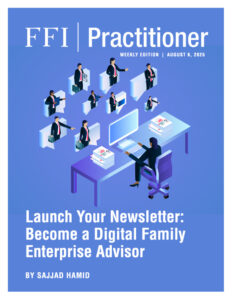
View this edition in our enhanced digital edition format with supporting visual insight and information.
Thank you to this week’s contributor, FFI Fellow Sajjad Hamid, discussing how the use of digital newsletters can help advisors increase their skills in today’s communication environment. In this article, he explores ways in which independent advisors can use a digital newsletter as part of a wider digital strategy, increasing their visibility in the field and attracting new clients.
“Become” is a much bigger word than most people think. “Become” is akin to transformation, shifting the paradigm, or surfing on another wave before the current one crashes on the beach. The digital landscape has upended global economies, industries, business operations, and personal livelihoods. The issue for many family enterprise advisors is how this shift impacts their advisory practice and the strategies they can deploy to maintain a competitive edge.
While the digital world offers various marketing options to a knowledge solopreneur, e.g., videos, email marketing, blogs, social media articles, e-books, podcasts, webinars, and online communities, each option requires a separate set of competencies to achieve objectives. Nonetheless, even though advising and consulting are often immersed in tradition, today’s solo practitioner who embraces the digital landscape has an expansive marketing and communications arsenal.
This article provides background on a new model and then focuses on the electronic newsletter format as a business development tool.
How to Become a Digital Knowledge Entrepreneur: Some Background and Suggestions
Previously, I wrote about the concept of the knowledge solopreneur and how advisors can embrace digital tech to grow their practice, introducing the Knowledge Solopreneur Development Model. In this article, I describe a new model—The Digital Knowledge Entrepreneur. This new model suggests that solo practitioners can transition from knowledge professionals to knowledge entrepreneurs by developing four competencies.
- Adopt an entrepreneurial mindset, like that of their family enterprise clients, who are often entrepreneurs.
- Develop a product to offer the market, a product that has some degree of innovation and key points of difference from other existing models.
- Develop a prototype based on the practitioners’ expertise with clients who have struggles; this is the business development stage and includes the clients’ feedback as the protype is refined.
- Deliver the product in a more finished format based on client feedback. The Digital Knowledge Entrepreneur model is experimental and iterative, as the advisor is testing the market.
While there are many digital newsletters, it is possible to create a unique one that stands out and demonstrates the advisor’s expertise. A newsletter is another way to reach a target market and develop a following. Most advisors acquire clients through referrals, in a strategy called outbound marketing. However, the newsletter offers another way to gain prospects—inbound marketing. Potential clients can reach out to advisors directly. A newsletter, therefore, becomes a part of the business development strategy, the third stage of the model.
The Digital Newsletter: A Digital Strategy Example
Before the digital transformation, if authors wanted to write an article, they would seek out a publisher and an editor and meet them, writing the article confirm to the publisher’s standards. Today, authors can be publishers, editors, and writers all in one by using digital platforms that are available for free or on a subscription basis, e.g., LinkedIn, Substack, Constant Contact, and Mailchimp.
As an example, my newsletter, SME Entrepreneurs Newsletter, is crafted for owners of small and medium-sized enterprises (SMEs). Since the family business market is considered a niche in Trinidad and Tobago, the SME Entrepreneurs Newsletter bundles articles on several topics, including marketing, HR, and scaling strategies—offering family enterprise advice. The newsletter’s value proposition differs from other entrepreneur periodicals, as many do not cover family-owned companies. Even with a family-owned focus, however, it is important to be clear about the demographics of the target audience, since first-generation entrepreneurs have different needs from multi-generation family enterprises.
My objective for this newsletter is not to be an influencer but to establish a brand and become a thought leader, opening doors for enquiries in areas where family companies struggle, such as succession and strategic planning, governance, conflict resolution, scaling, and philanthropy.
Another strategy is a freemium platform on which some content can be offered for free, but just enough to encourage prospects to reach out. This inbound marketing helps attract business prospects.
A digital newsletter can also earn revenue directly when sold as a subscription. If the newsletter has a large subscriber base, it can offer advertising space to companies, such as banks for wealth management products and insurance firms for keyman insurance.
Ultimately, a practitioner must carefully decide on the name of the newsletter, for branding purposes, and the frequency of the publication. With regard to frequency, a weekly edition requires more content than a bi-weekly one, but a quarterly cycle may be too infrequent. Artificial intelligence (AI) is an important resource as these decisions are made since the audience frequently wants fresh and insightful content with style and personality in the writing.
The Digital Newsletter: Converting Interest into Clients
The objective of a digital newsletter is to build a database and convert readers into clients. One way to do this is to offer content that explores readers’ and clients’ struggles in the areas outlined above. Another is to advertise upcoming webinars or podcasts. Yet another is to have a section for feedback, where responses can be posted on an online community. However, the confidentiality issues in this field require knowing and following privacy protocols.
Another possibility is to include the newsletter in premium subscription bundles. This strategy is used by magazines such as Harvard Business Review (HBR) and Scientific American. If an advisor’s newsletter does not accompany a digital magazine, the newsletter can be tied to other digital products, such as e-books, webinars, and courses. Additionally, family enterprise advisors can be invited to write guest columns or conduct interviews.
Conclusion
Advisors who use new tools and strategies to thrive in the digital landscape are growing in numbers. Digital marketing opens a new paradigm that was once dominated by larger organizations, such as publishing houses and multimedia firms. Today, however, a knowledge solopreneur, even from the comfort of a home office, can utilize inexpensive software to reach a global audience, often becoming a recognized digital expert.
About the Contributor

Sajjad Hamid, FFI Fellow, is a SME and family business advisor. He teaches family business and entrepreneurship at The College of Science, Technology, and Applied Arts of Trinidad and Tobago. He has a column in the Trinidad and Tobago Guardian newspaper and is the author of Build Your Legacy Business: Solopreneur to Family Business Hero. He can be reached at entrepreneurtnt@gmail.com.

View this edition in our enhanced digital edition format with supporting visual insight and information.





